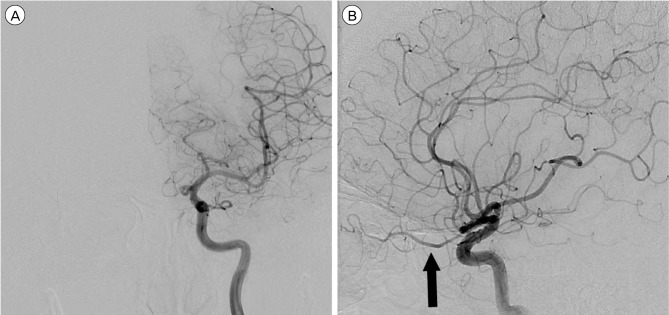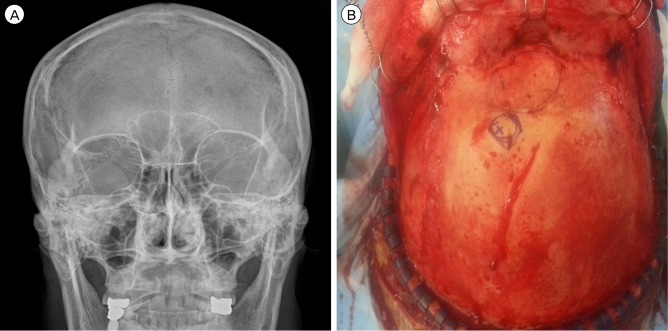1. Agid R, Terbrugge K, Rodesch G, Andersson T, Soderman M. Management strategies for anterior cranial fossa (ethmoidal) dural arteriovenous fistulas with an emphasis on endovascular treatment. J Neurosurg. 2009; 1. 110(1):79–84. PMID:
18847336.

2. Borden JA, Wu JK, Shucart WA. A proposed classification for spinal and cranial dural arteriovenous fistulous malformations and implications for treatment. J Neurosurg. 1995; 2. 82(2):166–179. PMID:
7815143.

3. Cognard C, Gobin YP, Pierot L, Bailly AL, Houdart E, Casasco A, et al. Cerebral dural arteriovenous fistulas: clinical and angiographic correlation with a revised classification of venous drainage. Radiology. 1995; 3. 194(3):671–680. PMID:
7862961.

4. Davies MA, TerBrugge K, Willinsky R, Coyne T, Saleh J, Wallace MC. The validity of classification for the clinical presentation of intracranial dural arteriovenous fistulas. J Neurosurg. 1996; 11. 85(5):830–837. PMID:
8893721.

5. Ducic Y, Coimbra C. Minimally invasive transfrontal sinus approach to resection of large tumors of the subfrontal skull base. Laryngoscope. 2011; 11. 121(11):2290–2294. PMID:
22020880.

6. Halbach VV, Higashida RT, Hieshima GB, Wilson CB, Barnwell SL, Dowd CF. Dural arteriovenous fistulas supplied by ethmoidal arteries. Neurosurgery. 1990; 5. 26(5):816–823. PMID:
2191241.

7. Hashiguchi A, Mimata C, Ichimura H, Morioka M, Kuratsu J. Venous aneurysm development associated with a dural arteriovenous fistula of the anterior cranial fossa with devastating hemorrhage-case report. Neurol Med Chir (Tokyo). 2007; 2. 47(2):70–73. PMID:
17317944.

8. Hoh BL, Choudhri TF, Connolly ES Jr, Solomon RA. Surgical management of high-grade intracranial dural arteriovenous fistulas: leptomeningeal venous disruption without nidus excision. Neurosurgery. 1998; 4. 42(4):796–804. discussion 804-5PMID:
9574644.

9. Im SH, Oh CW, Han DH. Surgical management of an unruptured dural arteriovenous fistula of the anterior cranial fossa: natural history for 7 years. Surg Neurol. 2004; 7. 62(1):72–75. discussion 75PMID:
15226079.

10. Jimbo H, Ikeda Y, Izawa H, Otsuka K, Haraoka J. Mixed pial-dural arteriovenous malformation in the anterior cranial fossa--two case reports. Neurol Med Chir (Tokyo). 2010; 50(6):470–475. PMID:
20587971.
11. Kakarla UK, Deshmukh VR, Zabramski JM, Albuquerque FC, McDougall CG, Spetzler RF. Surgical treatment of high-risk intracranial dural arteriovenous fistulae: clinical outcomes and avoidance of complications. Neurosurgery. 2007; 9. 61(3):447–457. discussion 457-9PMID:
17881955.
12. Kohama M, Nishimura S, Mino M, Hori E, Yonezawa S, Kaimori M, et al. Anterior cranial fossa dural arteriovenous fistula with bilateral cortical drainers-case report. Neurol Med Chir (Tokyo). 2010; 50(3):217–220. PMID:
20339271.
13. Lasjaunias P, Chiu M, ter Brugge K, Tolia A, Hurth M, Bernstein M. Neurological manifestations of intracranial dural arteriovenous malformations. J Neurosurg. 1986; 5. 64(5):724–730. PMID:
3701421.

14. Lawton MT, Chun J, Wilson CB, Halbach VV. Ethmoidal dural arteriovenous fistulae: an assessment of surgical and endovascular management. Neurosurgery. 1999; 10. 45(4):805–810. discussion 810-1PMID:
10515474.

15. Liu JK, Dogan A, Ellegala DB, Carlson J, Nesbit GM, Barnwell SL, et al. The role of surgery for high-grade intracranial dural arteriovenous fistulas: importance of obliteration of venous outflow. J Neurosurg. 2009; 5. 110(5):913–920. PMID:
19199500.

16. Magro E, Engel D, Bojanowski MW. Transfrontal sinus approach for an anterior cranial fossa, ethmoidal, dural arteriovenous fistula. Surg Neurol Int. 2014; 12. 5:172. PMID:
25593756.

17. Maier P, Feltgen N, Lagrèze WA. Bilateral orbital infarction syndrome after bifrontal craniotomy. Arch Ophthalmol. 2007; 3. 125(3):422–423. PMID:
17353420.

18. Riva CE, Titze P, Hero M, Petrig BL. Effect of acute decreases of perfusion pressure on choroidal blood flow in humans. Invest Ophthalmol Vis Sci. 1997; 8. 38(9):1752–1760. PMID:
9286263.
19. Soderman M, Pavic L, Edner G, Holmin S, Andersson T. Natural history of dural arteriovenous shunts. Stroke. 2008; 6. 39(6):1735–1739. PMID:
18388337.

20. Suzuki J, Mizoi K, Yoshimoto T. Bifrontal interhemispheric approach to aneurysms of the anterior communicating artery. J Neurosurg. 1986; 2. 64(2):183–190. PMID:
3944627.
21. Tanei T, Fukui K, Wakabayashi K, Mitsui Y, Inoue N, Watanabe M. Dural arteriovenous fistula in the anterior cranial fossa: four case reports. Neurol Med Chir (Tokyo). 2008; 12. 48(12):560–563. PMID:
19106494.
22. van Dijk JM, terBrugge KG, Willinsky RA, Wallace MC. Clinical course of cranial dural arteriovenous fistulas with long-term persistent cortical venous reflux. Stroke. 2002; 5. 33(5):1233–1236. PMID:
11988596.

23. Yakes WF, Krauth L, Ecklund J, Swengle R, Dreisbach JN, Seibert CE, et al. Ethanol endovascular management of brain arteriovenous malformations: initial results. Neurosurgery. 1997; 6. 40(6):1145–1152. discussion 1152-4PMID:
9179886.

24. Zhao WY, Krings T, Yang PF, Liu JM, Xu Y, Li Q, et al. Balloon-assisted superselective microcatheterization for transarterial treatment of cranial dural arteriovenous fistulas: technique and results. Neurosurgery. 2012; 12. 71(2 Suppl Operative):ons269–ons273. discussion ons273PMID:
22791037.







 PDF
PDF ePub
ePub Citation
Citation Print
Print



 XML Download
XML Download